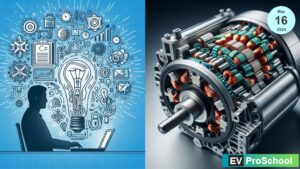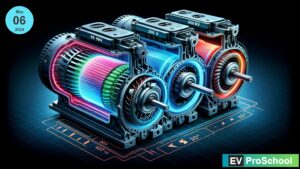Imagine you have a magical spinning top that can spin endlessly without ever stopping. This is similar to what an electric motor does, but instead of magic, it uses electricity! At the heart of this fascinating gadget is something called “motor winding.” These windings are like the secret paths on which our magical electric current travels, creating an invisible force that spins the motor around.
The Spiral Roads of Electricity: Motor Windings
Motor windings are made from copper wire, coiled around the motor’s parts like spirals. Think of these spirals as roads on which our tiny electric cars (the electric current) race. Depending on how these roads are built, they can make our spinning top (the motor) spin faster, stronger, or more efficiently.
The Invisible Force Field: Inductance
Now, let’s introduce a hidden character in our story: inductance. Inductance is like a magical force field around each spiral road. When our electric cars speed along these roads, they create this force field. The more twists and turns (or coils) our road has, the stronger this magical field becomes.
The Dance Between Windings and Inductance
Imagine if, by changing the strength of our magical force field (inductance), we could control how fast or how strong our spinning top spins. That’s exactly what happens in an electric motor! The relationship between the windings and their inductance is like a dance, where each step affects the motor’s performance.
Image Prompt for DALL-E: An engaging, colorful illustration depicting electric current as tiny racing cars moving through coiled wire roads around a motor, with glowing, mystical fields (representing inductance) surrounding them, highlighting the dynamic interaction between current and magnetic fields.
Why This Dance Matters
- Efficiency: Like choosing the best path to get to your friend’s house, the way windings are coiled can make the motor use less energy to do its job.
- Power: The strength of our motor’s spinning can be adjusted by changing the windings, much like how a stronger push can make your spinning top spin faster.
- Control: By understanding this dance, engineers can design motors that are just right for their tasks, whether it’s powering a small toy or driving a big electric car.
For the Curious Minds: Dive Deeper
If you’re fascinated by how this invisible dance creates motion, think about a simple experiment. When you use a magnet near some metal objects, they move without touching them, right? That’s similar to how inductance works in our motor windings, creating motion out of thin air (well, electric currents and magnetic fields, to be precise!).
Conclusion: The Endless Dance of Electric Motors
In the grand ballet of electric motors, motor windings and inductance play the lead roles. This magical interplay is what powers everything from your tiny remote-controlled car to the electric buses on the streets. Understanding this dance not only helps engineers create better, more efficient motors but also opens a window for us into the fascinating world of electricity and magnetism.
Further Reading and Resources:
- “Electric Motors and Drives” by Austin Hughes – A comprehensive guide to understanding the principles and applications of electric motors.
- “The Art of Electronics” by Paul Horowitz and Winfield Hill – While not solely focused on motors, this book provides an invaluable foundation in understanding the electronic principles behind motor control.
- Online courses and videos on electric motor design – Platforms like Coursera, Khan Academy, and YouTube offer accessible lessons ranging from basic principles to advanced motor design techniques.
SEO Keywords: Electric motor winding, motor winding inductance, efficiency, power, control, electric motor design, magnetic fields, electrical current.
Now, let’s generate the feature image and related images to visually enhance this journey into the heart of electric motors.
Here’s a visual journey into the fascinating world of electric motors, exploring the crucial roles of motor windings and inductance:
Feature Image
Our feature image offers a vibrant, simplified glimpse into an electric motor, showcasing the winding wires and the magical dance of electricity and magnetic fields within. This illustration sets the stage for our exploration of how these elements power the motion and efficiency of electric motors.
The Dynamic Dance of Current and Magnetic Fields
Our second image brings to life the concept of electric current flowing through motor windings, depicted as tiny racing cars on coiled wire roads. The surrounding mystical fields symbolize inductance, illuminating the interaction between current and magnetic fields that drives the motor’s movement.
These illustrations serve not just as a feast for the eyes but as a gateway to understanding the complex principles that make electric motors an indispensable part of modern technology. From powering the smallest toys to driving the most significant innovations in electric vehicles, the dance between motor windings and inductance continues to propel us forward into an electrified future.
For those keen on delving deeper into the mechanics of electric motors and their applications, the recommended readings and resources offer a wealth of knowledge to satisfy both the curious mind and the aspiring engineer.


